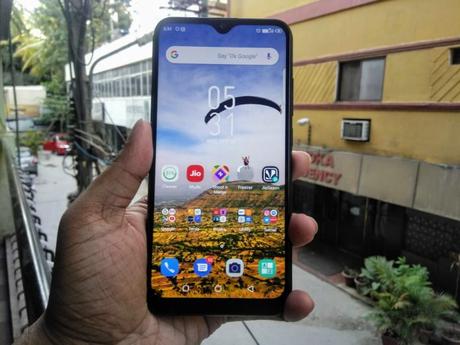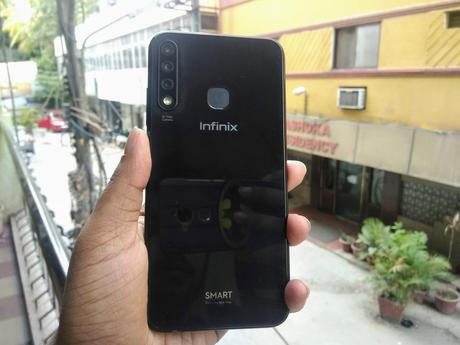
The entry-level segment for smartphones is getting competitive day-by-day. The basic idea behind all devices falling in that category is to provide as many features (both hardware and software related) in as few bucks as possible. While this strategy may work for first-time smartphone buyers, it is a miss for the rest. Moreover, the overall experience borders more on the annoying side than on the useful one, which may result in the first-time buyers either increasing their budget for the next purchase (which is good for the industry), or completely shy away from the product that is 'smartphone', or maybe try another budget device but from a different brand. The third possibility is the most likely, and it is not a good sign for any brand.
Nevertheless, in this review, I try to find out what the Infinix Smart 3 Plus is all about, and at 6,999 INR whether it is a bang for your buck.
The ergonomic design of the Infinix Smart 3 Plus is impressive on first look. The rounded edges make for a better grip. The polycarbonate unibody design comes with a glossy glass finish, which makes the device prone to fingerprint smudges, a trade-off for the looks.
The front houses a waterdrop notch at the centre, with an 8 MP camera lens and an earpiece on top. No dedicated LED flash for selfies, which could be considered a let-down. It is compensated with a software-based screen flash.

The triple camera setup at the rear is powered by artificial intelligence, and along with the dual tone LED flash, is placed vertically on the top left. It is enclosed in a curved oval frame made up of the same plastic as the frame, below which are the words 'AI - Triple Camera' engrossed in silver. The fingerprint sensor sits in the middle of the top half, with the Infinix branding below it. The series name (Smart) in all capitals is written at the bottom centre, with another "Designed by Infinix" branding below it. The only way to hide all that text from plain view is to use a cover. Thankfully, one is available in the box.
The micro USB charging port is in the middle at the bottom, with either side having a 3.5 mm headphone jack along and the speaker grille. The primary microphone lies in between the headphone jack and the charging port.
The right side of the smartphone contains the volume rocker button and a textured power button. The left contains the SIM tray which supports dual nano SIM cards, and a dedicated microSD card for external storage.
The box also contains a SIM ejector tool, and a charging adapter with a micro USB cable.
Infinix Smart 3 Plus boasts of a 6.21-inch HD+ screen with a resolution of 1520×720 pixels. With 2.5D glass cover, 88% screen-to-body ratio, and 500 nits brightness, it looks impressive. The ugly notch results in reduced bezels on three sides, with a thicker chin in comparison. I prefer not having the notch, but it seems to be all the rage these days. The notch can be hidden with a UI tweak, which is a welcome move for no-notch lovers like me.
The bright and vivid display works as expected even under direct sunlight. The humongous size makes it a good candidate for consuming video content and playing games, but the reduced sharpness and lesser pixels-per-inch fail to render the content according to its quality.
Infinix Smart 3 Plus sports a tripe camera setup (13 MP + 2 MP + low light) on the rear with dual LED flash. The artificial intelligence integration allows the setup to identify the condition in which it is being used, and thus select a mode automatically. For instance, it can determine and choose among HDR, night, or sports mode depending on the scene in the view. Moreover, the AI mode is the default mode. There is no switching it off! Thus, one is to rely on the intelligence, failing which the shots won't come out as expected. The front shooter is an 8 MP lens.
It is well-known that a budget phone compromises on its camera, and the fact holds true for this device as well. Even though we see three lenses working in tandem to produce the final image, the result is far from impressive. Edge detection in the bokeh mode is way off, with a lot of blurry lines and white noise popping in - clearly proving that increasing the number of lenses is not enough and that software post-processing is required to produce wonderful images. The autofocus takes its own sweet time to kick in, which is annoying to say the least. The lowlight shots contain more grains and noise than one would expect, and the artificial light that one must expect to be added in that mode appears to be missing altogether.
Conclusively, the camera setup looks impressive on paper, but that is where the advantage ends. It fails miserably when used in the real world.
The front shooter captures decent selfies in daylight, but the photos lose sharpness as the lighting conditions degrade. The selfies get overexposed unless manually adjusted. Edge detection in the portrait mode has a similar fate as that of the rear camera setup. The front camera also has an AR mode, wherein the face is decorated with various augmented reality stickers.
Everything said and done, the triple camera setup fails to live up to its expectations.
Infinix Smart 3 Plus runs on the MediaTek Helio A22 chipset. It is supported by 2 GB RAM, and 32 gigs internal storage which is expandable via the dedicated slot.
The primary memory is not enough to support a smooth multi-tasking experience. Lag was observed when opening and using apps when a few of them were already running. Playing basic games was a smooth experience overall, with a few instances of sluggish behaviour over time.
The fingerprint sensor does a decent enough job of unlocking the device.
Infinix Smart 3 Plus runs on the custom skin XOS 5.0 (codenamed Cheetah) which runs on Android 9 Pie. The codename seems far fetched given that a Cheetah is known for its speed, while the experience on the phone proves otherwise.
Custom skin shouldn't necessarily mean bloatware, but that is not the case here. Non-removable apps take up space, which is unacceptable. A few features like the Read Mode, Eye Care, recently used apps shortcut, are a welcome step in the direction of improving overall device experience.
Software-based face unlock is a welcome feature in a budget device like this. It works well, even in low-light. It is, by far, my favourite feature of the Infinix Smart 3 Plus.
Infinix Smart 3 Plus is powered by 3,500 mAh battery. It may sound smaller but is huge when used in the real world. On moderate usage, it easily lasts for a day, still leaving some juice for the next. It is the second thing I like about this phone.

Ankit writes code for a living. He reviews gadgets and books in his free time, and believes in the magical power of a strong cup of coffee.
